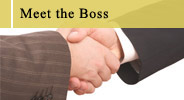Who’s really in charge of running your business?Founder of O’Briens Sandwich Bars, BRODY SWEENEY, continues his series on how to cope with the stresses and strains of starting a new enterprise
What gets measured gets done You need to set clearly defined targets for yourself and those working with you and constantly measure yourself against these targets to see how you’re doing.
Setting targets is part of the planning process. All businesses – not just new business start-ups – should have a plan for each year. Even a small business should have a simple one-page plan setting out clearly defined objectives for the year ahead. This should then be shared with those working with you. If you show someone how to do a job, or what the overall plan is, and they agree with your expectations of them, there are no excuses.
This is the reason most medium-sized businesses do monthly management accounts. Targets are set and broken down into monthly objectives, and then the accounts measure the actual performance of the business.
Communicate your vision If you expect the people who work with you to buy into your grand plan for the business, you need to tell them what that plan is.
When we want to achieve something in O’Briens, the first thing we do is set clear long-term – or ‘big picture’ – goals, and then break these goals down into more manageable, bite-sized chunks. In management, there is the old story about ‘eating an elephant’. If you imagine trying to eat an elephant in one go, it’s a daunting task, impossible to achieve; but if you break the elephant down into bite-sized chunks, you can eventually achieve your goal and eat the elephant.
In O’Briens, our big-picture goal is to open 1,000 stores over a set period of time. We have broken that goal down into smaller goals, which relate to how many stores we can open in one year. Everyone in the company has a fairly clear sense of both our big-picture goal and our short-term objectives en route to achieving that goal.
One of the exercises we go through, usually annually, is a process of visualisation that involves imagining what the company will look like in one or two years’ time, as opposed to what it looks like now. The visualisation exercise enables us to imagine what the various departments in the business would look like if the company was twice the size it is now. For example, what will having double the number of stores mean for our sales and marketing department? How will the operations department be affected? How will our financial people administer a bigger business? Will the management structure that is currently in place be sufficient as the company grows? How will the support we offer our franchise partners change?
By examining, through this visualisation exercise, all the issues that will affect our organisation and the likely impact that its expanded size will have on it, we can come up with a ‘big plan’. In that way, when the changes happen, they will not come as a surprise to the company’s staff. Secondly, we’re getting our staff to buy into the vision, and the part they can play in O’Briens making the transition to a business twice the size it is at the moment.
One of the things I think is particularly noticeable when you come into contact with O’Briens staff is the fact that no one is frightened by the prospect of running a chain of 1,000 stores. When you think of this in an Irish context, that is a huge business – one that’s outside the experience of almost all Irish business people.
By sharing our vision with everyone in the company and using these visualisation exercises, our people are prepared, confident and aware of the part they have to play in growing the business.
Inspire by example Your workmates will soon work out whether you are willing to lead by example, and that will affect what they are prepared to do for you. For example, when I visit one of our stores, if I see a dirty floor or table, I generally just clean it up myself. This sends a message to the store owner that I am prepared to put in the work on the ground myself – quite literally!
For the same reason, I would always allow a paying customer to be served before me in an O’Briens store: this sends out a signal about treating people correctly. It tends to be the little things you do rather than the big gestures that have the best effect.
Delegate, and trust people – but check, just in case It’s impossible to get on in business without trusting people. Except in the smallest of businesses, your job is to manage; it’s other people’s job to do. The more time you do the ‘doing’, the less time you will have to manage.
So delegate, but don’t assume that just because you have delegated, the job is done. A good example of this is with the use of e-mails. Have you noticed certain people’s tendency to send an e-mail and then assume the job is done? I don’t know how things are for you, but I typically get about 40 e-mails a day, and I know that I don’t read all of them in the detail I should. And if I don’t, how can I expect my colleagues to do so? So, after sending an e-mail, I usually phone a little later to see whether a particular job has been done.
It’s not a democracy Every-one’s leadership style is different. I think my personal style is to seek a consensus approach – although those who work with me may think differently! ‘Tough but fair’ seems to be what a good leader should aim for. ‘Tough’ because a business is not a democracy, and sometimes tough, unpopular decisions have to be taken; and ‘fair’ in the sense that you should try to take the effect that a particular decision will have on people into account.
As the ‘leader’ of O’Briens, I have a fairly clear idea about where we should be going. Not everyone around me agrees with that vision, or the way in which we are executing it, and that’s fair enough. But as long as I’m running the show, I think it’s my duty not to get distracted by people who don’t agree with it. Sure, a leader should be mature enough to change track if it is clearly demonstrated that they are wrong, but otherwise it’s their vision of how things should be that has helped get the business to where it is.
Two examples of me digging my heels in were over selling paninis and selling chips. I won’t allow them on the menu in O’Briens stores because, in the case of paninis all the other sandwich bars sell them and we need to be different, and in the case of chips, they’re deep-fried and therefore unhealthy, and we promote O’Briens meals as a healthy type of fast food.
Now, even though I didn’t agree to putting paninis on the menu, there was clearly a demand for a hot sandwich, so we invented a product that was uniquely ours, called a Toostie™, which satisfied all the requirements of a panini without having to be more of the same.
If you feel you’re right, there’s a good chance you are and you owe it to yourself to see it through, and to hell with the naysayers!
Next week: Don’t believe your own PR – how to know how your business is really doing
? Taken from Making Bread – The Real Way To Start Up and Stay Up in Business by Brody Sweeney, published by Liberties Press – buy at www.libertiespress.com and get a 10 per cent discount
Setting targets is part of the planning process. All businesses – not just new business start-ups – should have a plan for each year. Even a small business should have a simple one-page plan setting out clearly defined objectives for the year ahead. This should then be shared with those working with you. If you show someone how to do a job, or what the overall plan is, and they agree with your expectations of them, there are no excuses.
This is the reason most medium-sized businesses do monthly management accounts. Targets are set and broken down into monthly objectives, and then the accounts measure the actual performance of the business.
Communicate your vision If you expect the people who work with you to buy into your grand plan for the business, you need to tell them what that plan is.
When we want to achieve something in O’Briens, the first thing we do is set clear long-term – or ‘big picture’ – goals, and then break these goals down into more manageable, bite-sized chunks. In management, there is the old story about ‘eating an elephant’. If you imagine trying to eat an elephant in one go, it’s a daunting task, impossible to achieve; but if you break the elephant down into bite-sized chunks, you can eventually achieve your goal and eat the elephant.
In O’Briens, our big-picture goal is to open 1,000 stores over a set period of time. We have broken that goal down into smaller goals, which relate to how many stores we can open in one year. Everyone in the company has a fairly clear sense of both our big-picture goal and our short-term objectives en route to achieving that goal.
One of the exercises we go through, usually annually, is a process of visualisation that involves imagining what the company will look like in one or two years’ time, as opposed to what it looks like now. The visualisation exercise enables us to imagine what the various departments in the business would look like if the company was twice the size it is now. For example, what will having double the number of stores mean for our sales and marketing department? How will the operations department be affected? How will our financial people administer a bigger business? Will the management structure that is currently in place be sufficient as the company grows? How will the support we offer our franchise partners change?
By examining, through this visualisation exercise, all the issues that will affect our organisation and the likely impact that its expanded size will have on it, we can come up with a ‘big plan’. In that way, when the changes happen, they will not come as a surprise to the company’s staff. Secondly, we’re getting our staff to buy into the vision, and the part they can play in O’Briens making the transition to a business twice the size it is at the moment.
One of the things I think is particularly noticeable when you come into contact with O’Briens staff is the fact that no one is frightened by the prospect of running a chain of 1,000 stores. When you think of this in an Irish context, that is a huge business – one that’s outside the experience of almost all Irish business people.
By sharing our vision with everyone in the company and using these visualisation exercises, our people are prepared, confident and aware of the part they have to play in growing the business.
Inspire by example Your workmates will soon work out whether you are willing to lead by example, and that will affect what they are prepared to do for you. For example, when I visit one of our stores, if I see a dirty floor or table, I generally just clean it up myself. This sends a message to the store owner that I am prepared to put in the work on the ground myself – quite literally!
For the same reason, I would always allow a paying customer to be served before me in an O’Briens store: this sends out a signal about treating people correctly. It tends to be the little things you do rather than the big gestures that have the best effect.
Delegate, and trust people – but check, just in case It’s impossible to get on in business without trusting people. Except in the smallest of businesses, your job is to manage; it’s other people’s job to do. The more time you do the ‘doing’, the less time you will have to manage.
So delegate, but don’t assume that just because you have delegated, the job is done. A good example of this is with the use of e-mails. Have you noticed certain people’s tendency to send an e-mail and then assume the job is done? I don’t know how things are for you, but I typically get about 40 e-mails a day, and I know that I don’t read all of them in the detail I should. And if I don’t, how can I expect my colleagues to do so? So, after sending an e-mail, I usually phone a little later to see whether a particular job has been done.
It’s not a democracy Every-one’s leadership style is different. I think my personal style is to seek a consensus approach – although those who work with me may think differently! ‘Tough but fair’ seems to be what a good leader should aim for. ‘Tough’ because a business is not a democracy, and sometimes tough, unpopular decisions have to be taken; and ‘fair’ in the sense that you should try to take the effect that a particular decision will have on people into account.
As the ‘leader’ of O’Briens, I have a fairly clear idea about where we should be going. Not everyone around me agrees with that vision, or the way in which we are executing it, and that’s fair enough. But as long as I’m running the show, I think it’s my duty not to get distracted by people who don’t agree with it. Sure, a leader should be mature enough to change track if it is clearly demonstrated that they are wrong, but otherwise it’s their vision of how things should be that has helped get the business to where it is.
Two examples of me digging my heels in were over selling paninis and selling chips. I won’t allow them on the menu in O’Briens stores because, in the case of paninis all the other sandwich bars sell them and we need to be different, and in the case of chips, they’re deep-fried and therefore unhealthy, and we promote O’Briens meals as a healthy type of fast food.
Now, even though I didn’t agree to putting paninis on the menu, there was clearly a demand for a hot sandwich, so we invented a product that was uniquely ours, called a Toostie™, which satisfied all the requirements of a panini without having to be more of the same.
If you feel you’re right, there’s a good chance you are and you owe it to yourself to see it through, and to hell with the naysayers!
Next week: Don’t believe your own PR – how to know how your business is really doing
? Taken from Making Bread – The Real Way To Start Up and Stay Up in Business by Brody Sweeney, published by Liberties Press – buy at www.libertiespress.com and get a 10 per cent discount











